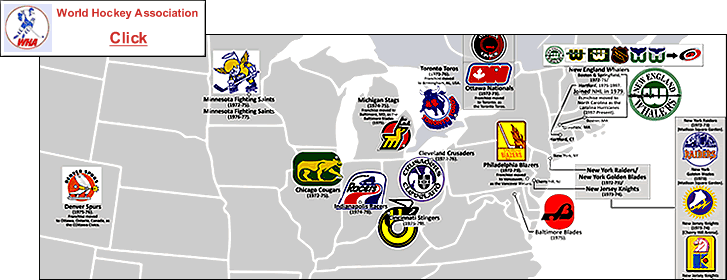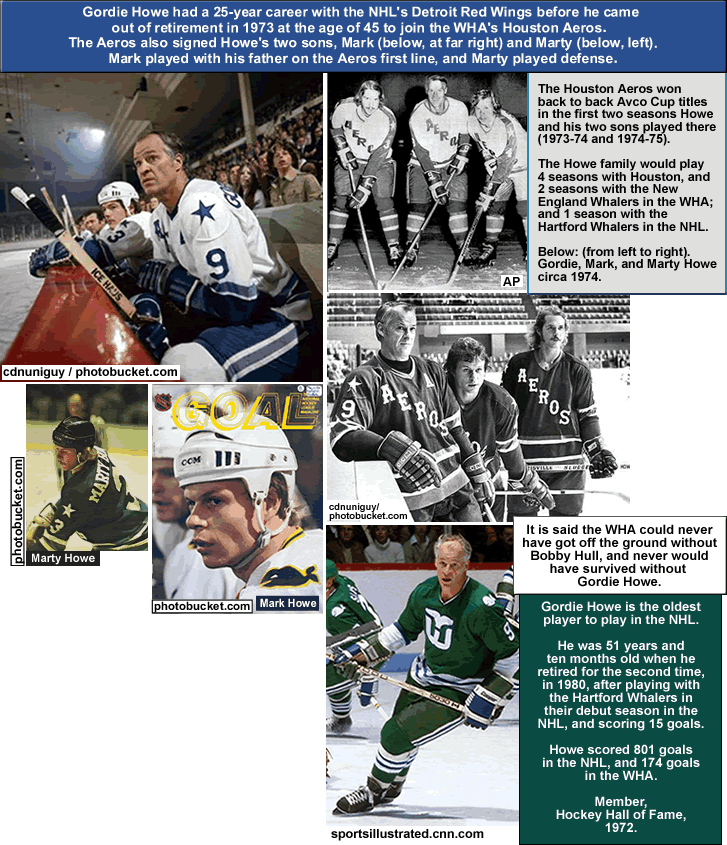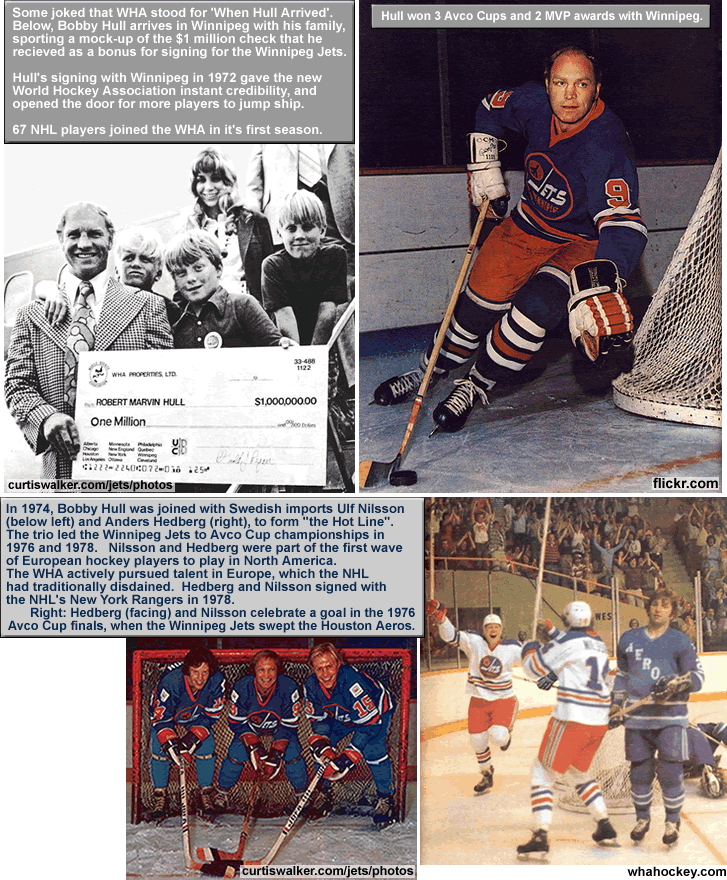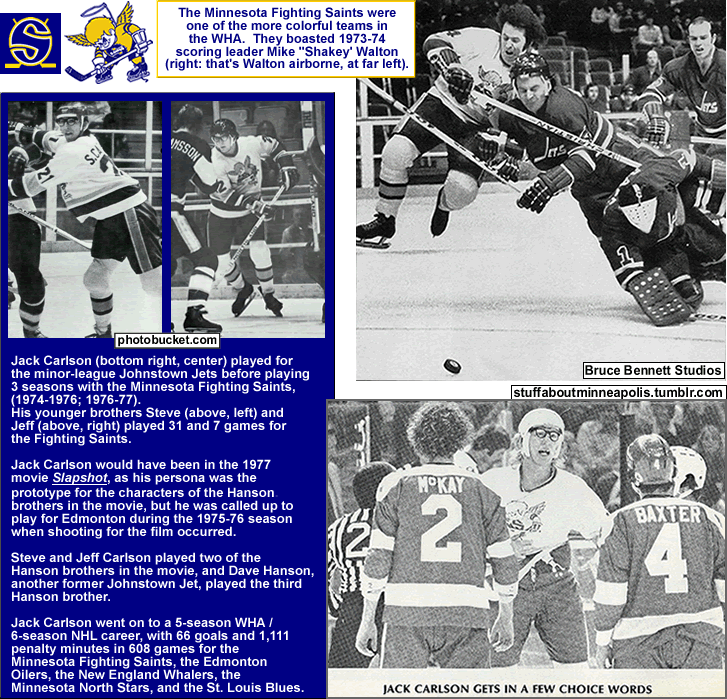
The World Hockey Association, 1972-73 to 1978-79: map of all 26 teams, with attendance figures and notes
…
…
The World Hockey Association was a professional ice hockey league that operated for 7 seasons in the 1970s. It was a rival league to the National Hockey League that was ultimately successful in that it put four of its teams into the NHL in 1979. Those four franchises still operate in the NHL, although only one, the Edmonton Oilers, have remained in the same city since its WHA days.
The other three WHA teams that joined the NHL in 1979-80 were the New England Whalers, the Quebec Nordiques, and the Winnipeg Jets. The Quebec Nordiques played 16 seasons in the NHL before moving in 1995 to Denver, Colorado, USA, as the Colorado Avalanche. The Winnipeg Jets played 17 seasons in the NHL before also moving across the border (in 1996), to Phoenix, Arizona, as the Phoenix Coyotes (named Arizona Coyotes since 2014-15]. The New England Whalers changed their name to the Hartford Whalers when they entered the NHL in 1979. The Whalers played 18 seasons in the NHL before they moved south to North Carolina, in 1997, as the Carolina Hurricanes.
-
The WHA was founded by sports promoters Dennis Murphy and Gary Davidson, who had been co-founders of the American Basketball Association (1967-1976), which challenged the National Basketball Association and eventually put 4 ABA teams in the NBA. 1971, the World Hockey Association was established, and began laying the groundwork for its first season, which would be in 1972-73, with 12 teams: 4 in Canada and 8 in the USA. The 12 teams that began play in 1972-73 were…Eastern Division: Cleveland Crusaders, New England Whalers, New York Raiders, Ottawa Nationals, Philadelphia Blazers, Quebec Nordiques. Western Division: Alberta Oilers, Chicago Cougars, Houston Aeros, Los Angeles Sharks, Minnesota Fighting Saints, Winnipeg Jets. 8 teams would make the playoffs and compete for the Avco Cup.
67 NHL players jumped to the WHA in the WHA’s first season. The move that gave the new league instant credibility was the signing of Chicago Black Hawks superstar Bobby Hull by the Winnipeg Jets. Hull was lured by the then-unheard of sum $1 million, which he received as a signing bonus (Hull earned $250,000 per year on top of that). Hull went on to be a two-time WHA MVP, scoring 77 goals in one season (1974-75). In a four-season period between 1974 and 1978, Hull’s teaming with Swedish line-mates Anders Hedberg and Ulf Nilsson led the Winnipeg Jets to the first two of the team’s three Avco Cup titles.
-
Before the first season began, in 1972, other WHA teams used a similar strategy of luring an NHL star or two to build a team around. The Philadelphia Blazers had goalie Bernie Parent, who they’d snatched from the Toronto Maple Leafs, and former Boston Bruins defenseman Derek Sanderson. The Cleveland Crusaders signed Boston Bruins goaltending star Gerry Cheevers. The Quebec Nordiques signed defenseman JC Tremblay, who’d bolted from the Montreal Canadiens. The New England Whalers stole defenseman Ted Green from the Boston Bruins. Green would captain the Whalers to the league’s first championship in 1972-73.
The NHL responded to all the incursions by the upstart WHA teams in two ways, by litigation (all of which failed to get their players back) and by blocking the WHA from forming teams in arenas, such as the newly built Nassau Coliseum in Long Island, New York. There, the NHL hastily assembled the expansion New York Islanders to play in 1972-73. The WHA’s New York Raiders were forced to rent Madison Square Garden on onerous terms which they could not keep up with due to lackluster attendance. The New York Raiders changed their name to the New York Golden Blades in 1973-74, then moved to south New Jersey halfway through the season, becoming the New Jersey Knights. The Knights played in a dilapidated 4,000 seat areana that had a slope in the ice that caused pucks to shoot up in the air. The franchise moved again, this time across the country to San Diego, where they became the San Diego Mariners, who lasted for three seasons as a competitive hockey club that drew around 6,000 per game.
The Houston Aeros got off to a rocky first season, then set about trying to find a marquee name to draw the spotlight. They came up with a promotional coup that in the end won them two championships. The Aeros persuaded NHL legend Gordie Howe to come out of retirement as a 45-year old and play with his two sons, Mark and Marty. Some felt this was just a cheap stunt to draw attention to the novelty of an ice hockey team in the Sunbelt, but no one was criticizing the Houston Aeros after the team won the Avco Cup in the first two seasons the Howe family played for them (1973-74 and 1974-75).

Gordie Howe scored 100 points his first season back, winning the 1973-74 MVP. Mark Howe won Rookie of the Year that season. The Aeros repeated as champions in 1974-75, then moved into the swank new Houston Summit, where they became one of the top 3 draws in the league, averaging 9,180 per game in 1975-76. But in 1976-77, the three Howes opted to sign with the New England Whalers. The Houston Aeros folded after the 1977-78 season, a year before the WHA did. Once it became known that the NHL wasn’t interested in a team in Houston, management cut their losses and did not play in the final WHA season of 1978-79.
-
Circa 1973-76, in Toronto, the Maple Leaf Gardens and Toronto Maple Leafs’ owner Howard Ballard did everything in his power to make life difficult for the WHA’s Toronto Toros, starting with charging an exhorbitant rent and including dimming the lights during Toros games, preventing the Toros from using the Leafs’ locker room, and taking away club house seat cushions. The Toros actually drew pretty well, averaging over 10,000 per game in 1974-75. And the Toros got back at Ballard by stealing some of his players, like Frank Mahovlich and Paul Henderson. But two years later the Toronto Toros gave up trying to compete with the Maple Leafs and moved to Birmingham, Alabama as the Birmingham Bulls, where they lasted until the end of the WHA in 1979, drawing over 8,000 in 1976-77 and 1977-78. The 1977-78 Bulls were maybe the largest collection of bruisers and goons ever assembled on a major league hockey team, including Steve Durbano and Dave Hanson. The Bulls management had got to understand the Birmingham fan base after 2 seasons there, and what those fans wanted there (in the Deep South which had no hockey tradition) was fights, and lots of them. In the book “Rebel League”, by Ed Willes, veteran sportswriter Al Strachan recalls going to a game during the 1977-78 season in Birmingham, when the Bulls hosted the New England Whalers. After the Star Spangled Banner and ‘Dixie’ were played, a priest blessed the players. About 4 minutes into the game, the fans started chanting “Bring in the goons, bring in the goons.” So Bulls coach Glen Sonmor sent in a line featuring three toughs including Gilles “Bad News” Bilodeau. Bilodeua immediately jumped the Whalers Mark Howe. The next shift, Dave Hanson started another fight. The crowd went wild. So this was essentially the routine for hockey night in Birmingham.
Another team with a pugilistic legacy was the aptly named Minnesota Fighting Saints. The Fighting Saints had the Carlson brothers, three big shaggy enforcers who wore dorky black plastic rimmed glasses while terrorizing opponents on the ice, and relaxed by playing slot-cars in their free time. If this all seems familiar, that’s because the Carlson brothers (particularly Jack Carlson) were the prototype for the characters of the Hanson brothers in one of the greatest sports movies ever made, Slap Shot (1977), which starred Paul Newman (and two of the three Carlsons) {see this, ‘Slap Shot’ (film), at en.wikipedia.org}. Right before he began his big-league career with the Fighting Saints, Jack Carlson had played for the minor-league Johnstown (Pennsylvania) Jets in 1974-75, and was a teammate of Ned Dowd, whose sister Nancy Dowd wrote the screenplay for the film.
The Minnesota Fighting Saints best moment was when they made it to the semi-finals of the Avco Cup playoffs for the second straight season in 1974-75, selling out the 16,000-capacity St. Paul Civic Center for some thrilling games versus the high-flying Quebec Nordiques. But the Fighting Saints could not compete in the crowded Minneapolis-St. Paul market with the NHL’s Minnesota North Stars, in spite of having attendances in the top 5 of the WHA (their best was 8,410 per game in ’74-75). The Fighting Saints could not meet payroll for much of the 1975-76 season, and did not last the season. The following season, 1976-77, the Cleveland Crusaders then moved to Minnesota as the reborn Minnesota Fighting Saints (with red and yellow instead of blue and yellow uniforms), but this team also could not last the season.
That was part of another instance of the NHL making a franchise move in response to the WHA.. The weakest NHL team, the California Golden Seals, moved to Cleveland, Ohio as the Cleveland Barons after the 1975-76 season. The somewhat successful WHA team the Cleveland Crusaders chose not to compete directly with an NHL team for fans in Cleveland and promptly moved to Minnesota as the second incarnation of the Minnesota Fighting Saints (where they had to compete with the Minnesota North Stars, but go figure; they obviously felt that Minnesota was a better market for two ice hockey teams than northeast Ohio). The Cleveland Barons were dissolved in 1978 (as the last NHL team to fold), while the second Fighting Saints did not last the 1976-77 season.
-
While the WHA saw relatively successful franchises being built in Edmonton, Winnipeg, Houston, Quebec, and Hartford (New England), all of the other WHA teams were on shaky ground. But in spite of this, the WHA expanded to 14 teams in 1974-75. [And insanely, the WHA also added 2 more expansion teams the following season in 1975-76: the Cincinnati Stingers (1975-1979), and the short-lived Denver Spurs (who folded before the end of their first season)] . The new teams in 1974-75 were the Indianapolis Racers and the Phoenix Roadrunners. Indianapolis drew well, with averages of 7,900; 8, 700; and 9,200 in their first three seasons. The Indianapolis Racers lasted until early in the final WHA season of 1978-79. The hockey club is now best known as the first pro team Wayne Gretzky played on, in 1978, when Gretzky was a 17-year old (and ineligible to play in the NHL). The Phoenix Roadrunners lasted three seasons in the WHA, with their highest average gate in their first season, when they drew 7,400 per game. Their star was Robbie Ftorek, whose MVP season in 1976-77 was still not enough to keep the team from folding.
-
The following link features a nice summary of the history of the Quebec Nordiques…from Third String Goalie blog, from Monday, June 21, 2010, 1995-96 Quebec Nordiques Prototype Jersey (thirdstringgoalie.blogspot.com).
-
Of their time in the WHA, the Edmonton Oilers only won one playoff series, and that was in the final season of 1978-79. In the first 4 seasons, the team pretty much was a perpetual .500 percentage club run by tireless promoter Bill L. Hunter, who despite his lack of hockey coaching acumen would perenially step in and replace the coach midway through the season…this happened in 1972-73, 1974-75, and 1975-76. The city of Edmonton had begun building a new hockey arena in 1973, with the hopes of attracting an NHL team, and the Oilers began playing at the Northlands Coliseum in November, 1974. Their gates, previously hampered by the small arena the team originally played in (see below), shot up to the top of the league in 1974-75. They drew 10,722 in 1974-75. The club was still mediocre, though, but the arrival of two individuals would soon change that: Glen Sather and Wayne Gretzky…
-
In all, 26 teams played in the World Hockey Association. 7 seasons were played, with the Winnipeg Jets winning 3 Avco Cup titles, the Houston Aeros winning 2 Avco Cup titles, and the New England Whalers and the Quebec Nordiques winning 1 Avco Cup title each.
The WHA effectively refuted the NHL’s postiion that there weren’t more than 3 cities in Canada capable of supporting a major league hockey team. The fact that 2 of those 3 Canadian WHA teams that made it into the NHL in 1979 were eventually moved to American cities doesn’t diminish the WHA’s importance to Canadian hockey fans. Had the WHA never existed, it is doubtful that the NHL would have ever put a team in Calgary in 1980 (thus making road trips to Edmonton that much more economical) or put a team back in Ottawa in 1992. And it is very doubtful the NHL woukd have ever put a team in Edmonton, whose Oilers went on to win 4 Stanley Cup titles in 5 years from 1984 to 1990. The WHA also is important for opening the door to European players, which in turn had a big influence in changing the game to the swift, skills-oriented passing game it is today.
And finally, the WHA is important to hockey players for challenging and legally removing the NHL’s reserve clause which (illegally) restricted hockey players’ rights and abilty to seek employment elsewhere when their contracts ended, thus allowing pro hockey players the chance to realize previously unheard of earning potential.
-
I recommend this site for further info on the late great WHA… http://www.whahockey.tv/ . There is lots of old video from WHA games here.
Here is but one, of New England Whaler Tom Webster scoring two sweet goals {click here}.
This one is not from that site, but I decided to end with this… ‘WHA Hockey’- Fights and Fashion’ (7:13), posted by galaxycorps, on Youtube {click here}.
-
Thanks to the contributors to the pages at en.wikipedia.org {click here}. Thanks to WHA Uniforms.com, for jerseys {click here}. Thanks to Super 70s.com, for attendance figures {click here}. Thanks to Chris Creamer’s Sports Logos Page {click here}. Thanks to WHA San Diego Mariners site {click here}. Thanks to Winnipeg Jets Online.com {click here}. Thanks to Joe Pelletier’s Greatest Hockey Legends site {Glen Sather page, here}.
Thanks to WHAhockey.com {click here}, for some of the photos, and for some of the facts.
Thanks to Ed Willes, for his book on the WHA…‘Rebel League, the short and unruly life of the World Hockey Association’, published by McLelland & Stewart, Toronto, 2004 {at Amazon, here}.




